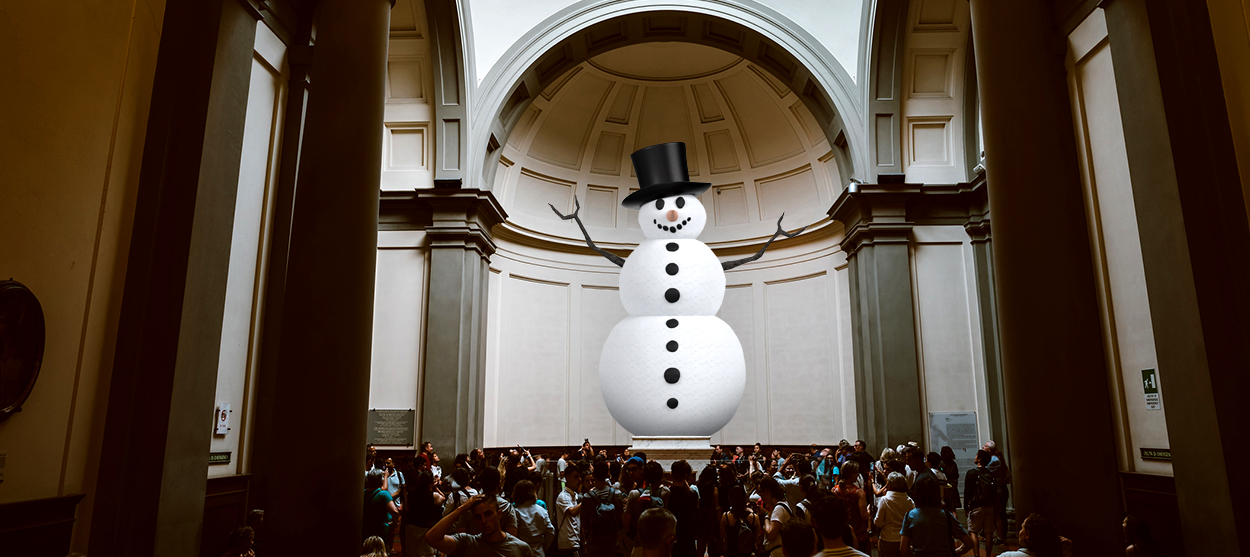How to build a perfect snowman
A matter of art and science


"Do you want to build a snowman?" a character asks in a film my children watch. This is not an idle query. It is a question of monumental importance, one with significant logistical, aesthetic, spiritual, and I daresay, alas, political and economic dimensions. This is particularly true if you are between the ages of 1 and 99. (I exclude centenarians only on grounds that will become clear later.)
The answer invariably is "yes, I wish to build a snowman." And yet I have lost count of the number of people (often but not always Southern transplants to my area of Michigan) I have met who have told me they failed on the one or two occasions when they had the opportunity of doing so.
There are many reasons for this, but most failures can be traced back to the same problem: There is no meaningful literature on the subject. Those of us who succeed in making snowmen do so because we were taught by our parents, who learned it from their grandparents, and so on back to ancestors very remote, if not to Adam and Eve.
The Week
Escape your echo chamber. Get the facts behind the news, plus analysis from multiple perspectives.

Sign up for The Week's Free Newsletters
From our morning news briefing to a weekly Good News Newsletter, get the best of The Week delivered directly to your inbox.
From our morning news briefing to a weekly Good News Newsletter, get the best of The Week delivered directly to your inbox.
It is this unfortunate deficit that I seek to address.
It must be understood first that the making of hominiform figures under conditions brumal is neither an art (in the sense that sculpture is) nor a science, but one of those bizarre messy human activities like fishing that exists somewhere between the two. It has it rules. Before anything else these must be established.
The most important one involves selecting the right sort of snow. Many people raised in warm climates will be surprised to learn there are different snows. To those of us who know better it is as absurd as asking an entomologist whether there are really multiple kinds of butterfly. Alas, even the barest descriptive catalogue of snow varieties would exhaust the space of a short column. It suffices to say that the thin powdery stuff that I think of as "doughnut hole snow" is insufficient. Nor can a snowman be built with the rather warm half-liquid snow speckled with bits of black that has the consistency of whatever goes into an Icee. Only the thick, almost clay-like packable snow that appears on days when it is barely cold enough to be snowing in the first place will do.
This brings us to the second point, which is waiting for the appropriate weather. One's heart goes out to all those poor Louisianans attending school in the Midwest who learn that it's going to drop below zero the next morning and upon waking rush into their front yards only to find that the would-be materials of creation pass through their fingers like dust. They must learn patience. The best sort of day for building a snowman is when it is about 25 or, better, 35 degrees out. Any warmer and you will have a slushy mess to work with; very much colder, and the snow will simply fail to come together.
A free daily email with the biggest news stories of the day – and the best features from TheWeek.com
So far we have discussed only those points which are beyond the control of the individual. I do not wish to give the impression that the building of snowmen depends entirely upon one's environment and that, so long as certain climatic conditions obtain, they will more or less build themselves. There are certain guidelines that must be adhered to.
One is that, generally speaking, real snowmen should be smaller than the ones we are accustomed to seeing in films or emblazoned on chintzy "holiday" decorations. This is true for a number of reasons, but the most important is simply that the larger the snowman, the more likely it is to fail. A good first snowman will have an abdomen only slightly larger than a basketball and a head that is correspondingly smaller. (This is another point on which cartoon snowmen can be misleading: the abdomen should always be significantly larger than the head, otherwise one runs the risk of seeing the latter fall off, which is horrifying, or of not being able to attach it in the first place.)
Another thing that must be understood about snowman creation — construction really is too ugly a word — is that it is not a task for gloved fingers. (This is why I suggested that older persons, and certainly those aged 100 or older, should not participate, except at their own risk.) It is just about about possible, one grants, to create a hideous dented blob that resembles a sphere about as much as a ham does a model of Jupiter while wearing gloves or mittens. But the actual task of rolling — to say nothing of the really fine work of shaping and smoothing, and the crucial step of attaching the head to the abdomen — must be undertaken by someone who is willing to remove his or her gloves in the cold. It is an occupational hazard, of course, but one well worth the risk. Even very small children like mine recognize this almost immediately; after a few moments of hopeless fumbling, they toss their gloves into the frozen waste with an admirable heedlessness and apply newly benumbed digits to their work. It is only inexperienced adults who, in their excess of caution, fail to apprehend this blinkeringly obvious point.
Last, it is worth offering a few particulars of what one might call style. Contrary to certain cartoon depictions, under no circumstances should a snowman have a mouth. Nor should his nose be made of anything but a carrot. His eyes, however, do need not be made of buttons — stones, coins, gum balls: anything for which an appropriately sized hole can be punched into the head without splitting it will do equally well. Hats, I think, should be considered optional at best; sticks, and sticks only, must be used for arms, which all snowmen require. Under no circumstances should a snowman be given a pipe (though I have seen a few sporting cigarettes courtesy of college-aged wags).
So much for practical advice. Even the most sober-minded craftsman, after many years of plying his trade, sooner or later develops certain opinions or theories touching on what one might call the "higher" aspects of his work. Among these must be numbered the important question of why for persons of all ages the act of building snowmen is the source of so much delight. For my part I have long suspected that in addition to the more obvious pleasures — being outdoors in beautiful but harsh weather, though not the harshest; the absurd experience of carrying uncooked vegetables through snow; the promise of hot cocoa or coffee waiting for one afterwards, along with the indescribable feeling of safety and comfort that comes with changing from a wet pair of socks into a warm one — there is something I have never seen alluded to. This is the chance of bringing something with rational form into being out of the barest elements — not a block of precious marble mined by hard professionals from a quarry, but stuff that falls from the sky in vast quantities in front of one's own house. It unites us, as so many wholesome activities do, with our creator, who also formed something pleasing to Himself out of what had previously been on the ground.
We can enjoy the overwhelming, totally gratuitous satisfaction of looking upon our creation — perhaps from the vantage point of a kitchen window, with a steaming mug in our hands — and saying that it, too, is good.
Matthew Walther is a national correspondent at The Week. His work has also appeared in First Things, The Spectator of London, The Catholic Herald, National Review, and other publications. He is currently writing a biography of the Rev. Montague Summers. He is also a Robert Novak Journalism Fellow.
-
 ‘Maps are the ideal metaphor for our models of what the world might be’
‘Maps are the ideal metaphor for our models of what the world might be’Instant Opinion Opinion, comment and editorials of the day
-
 What is China doing in Latin America?
What is China doing in Latin America?Today’s Big Question Beijing offers itself as an alternative to U.S. dominance
-
 ‘One Battle After Another’ wins Critics Choice honors
‘One Battle After Another’ wins Critics Choice honorsSpeed Read Paul Thomas Anderson’s latest film, which stars Leonardo DiCaprio, won best picture at the 31st Critics Choice Awards
